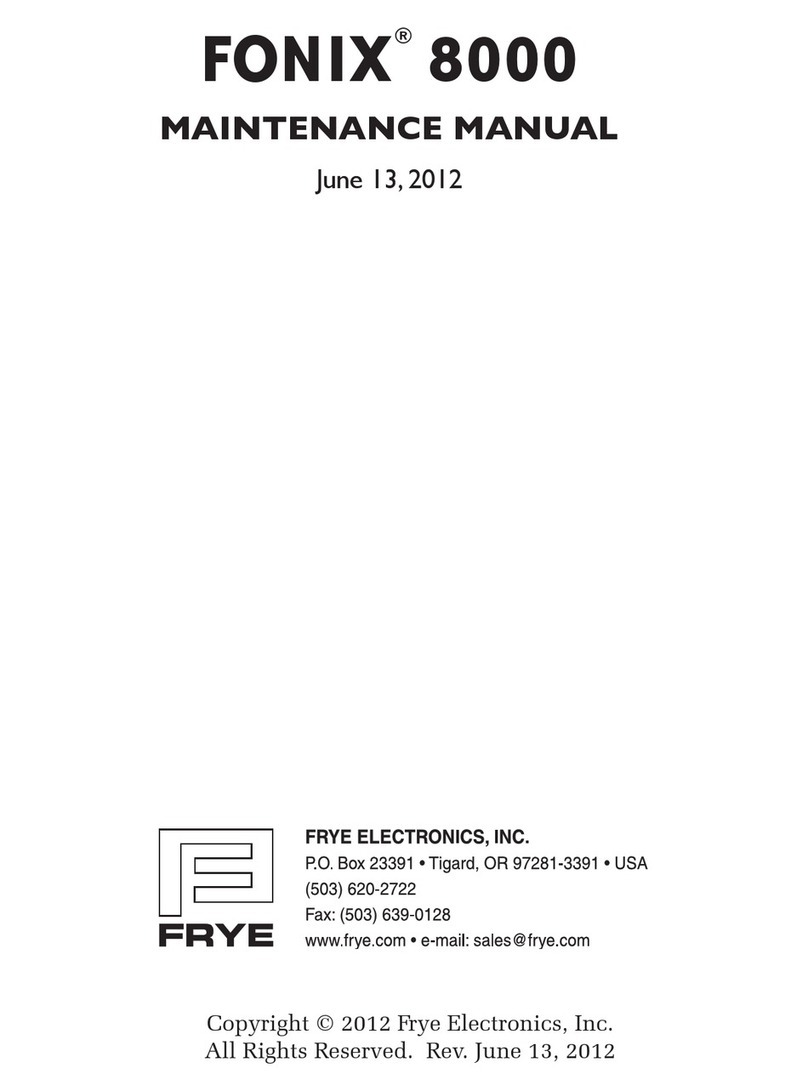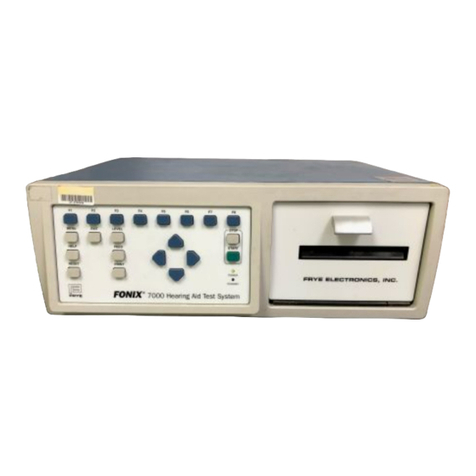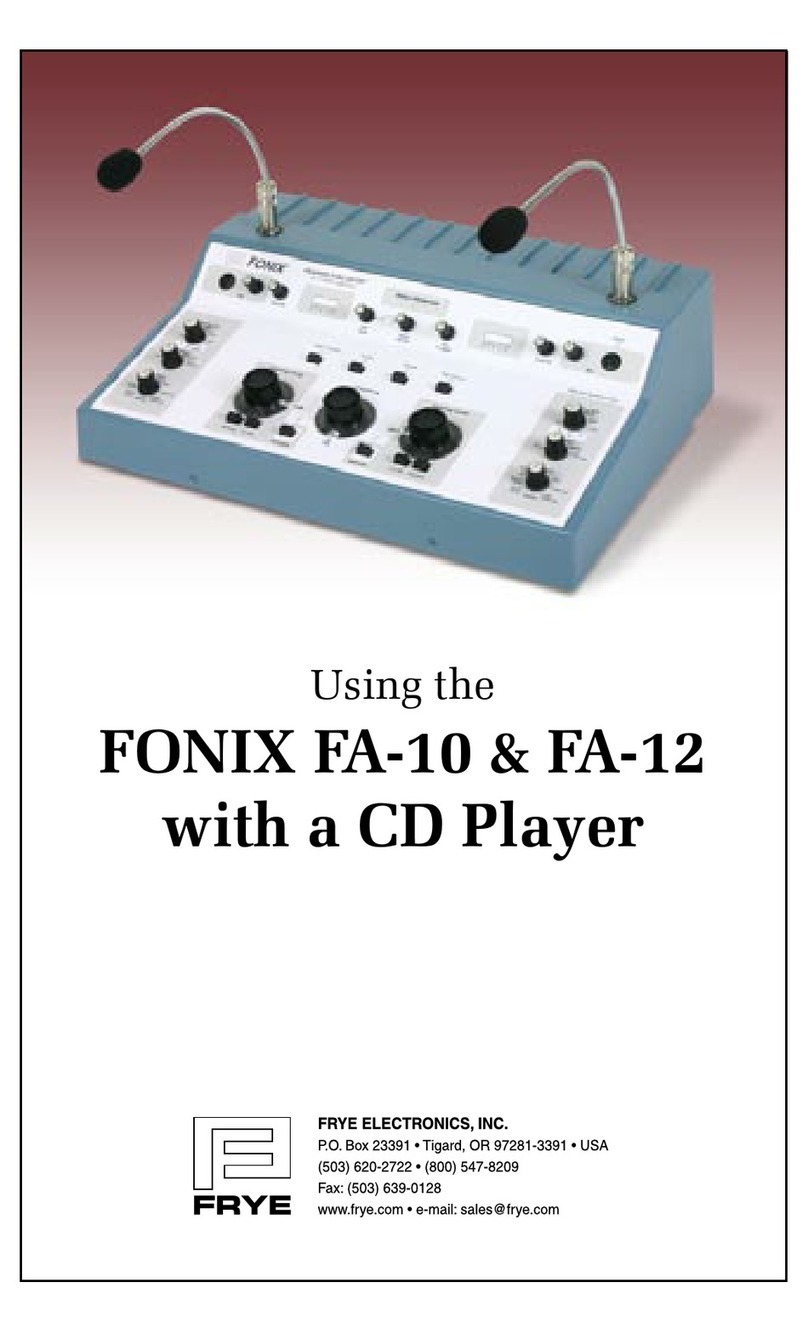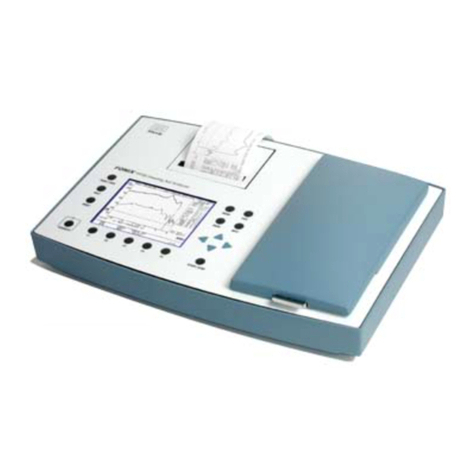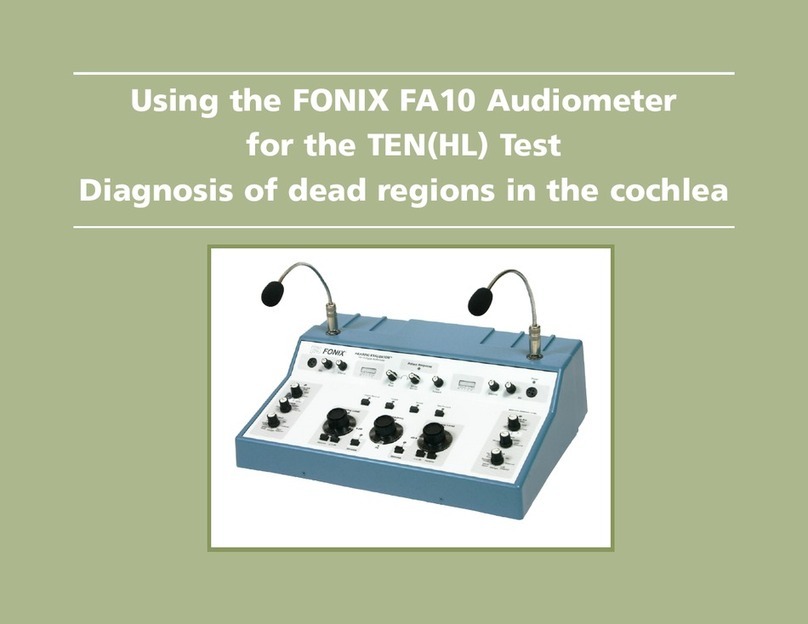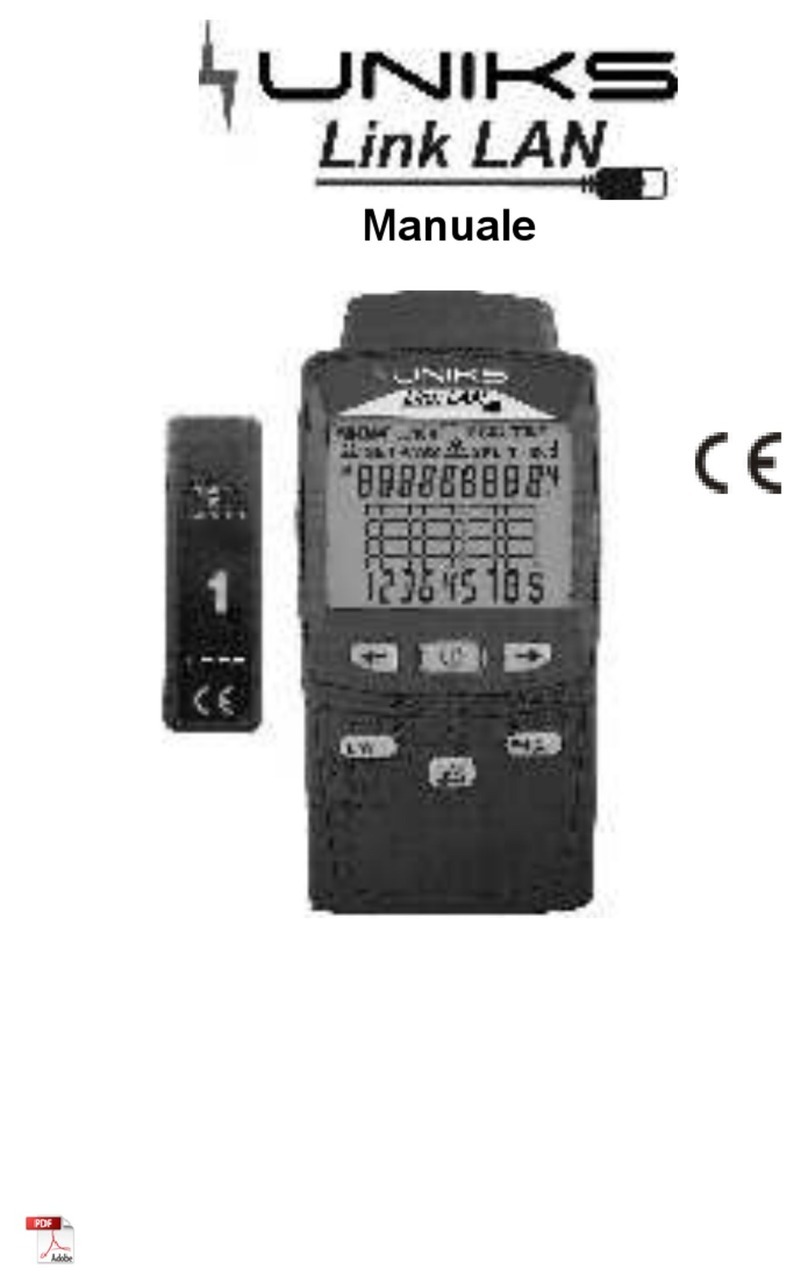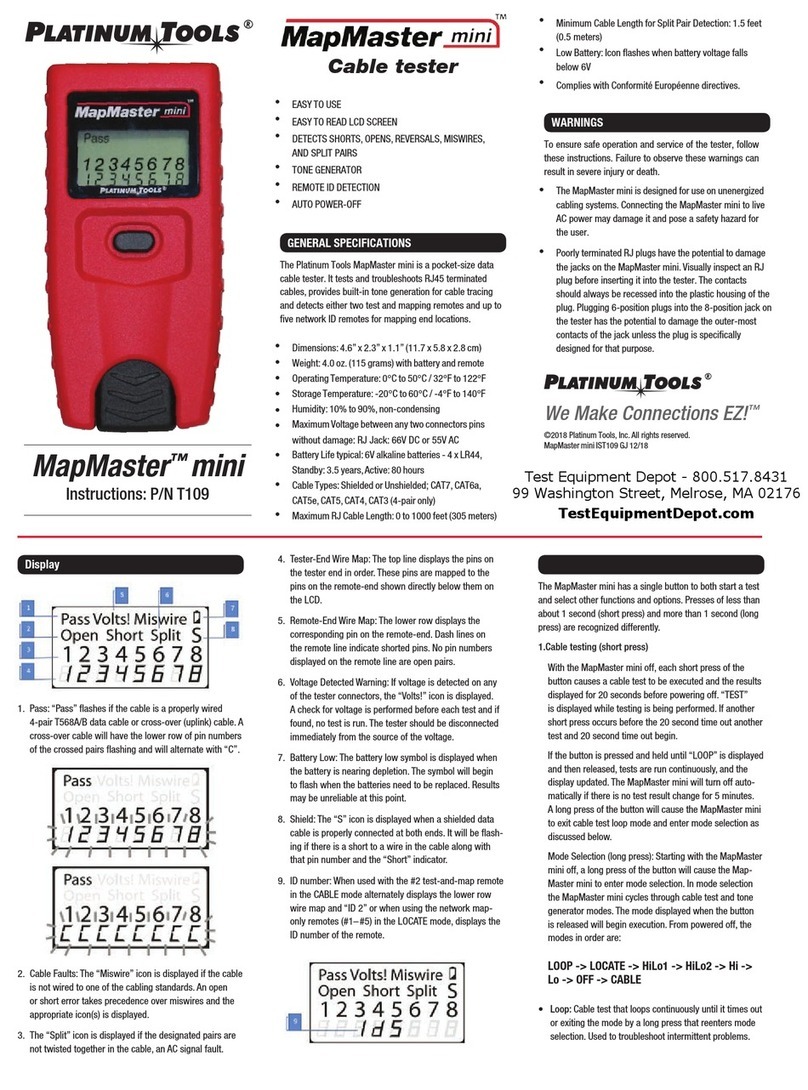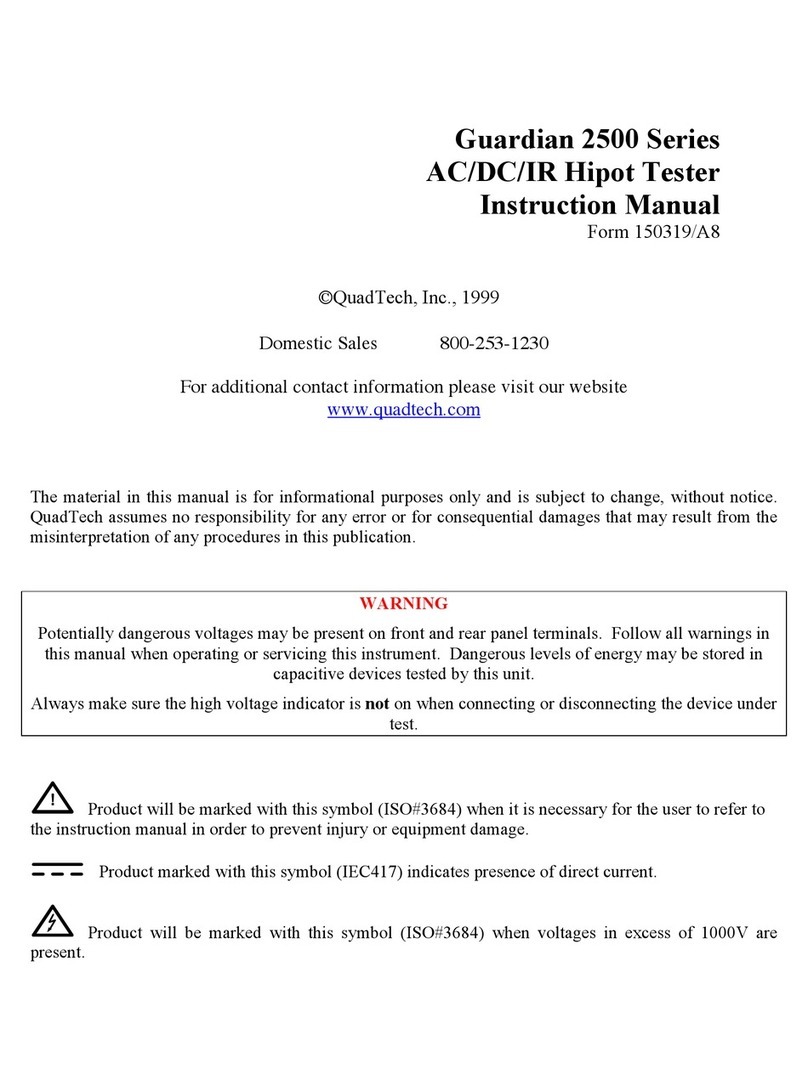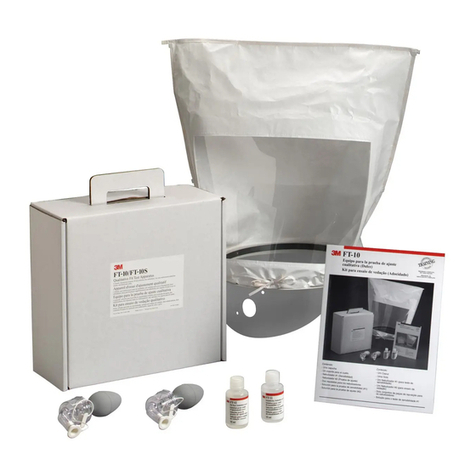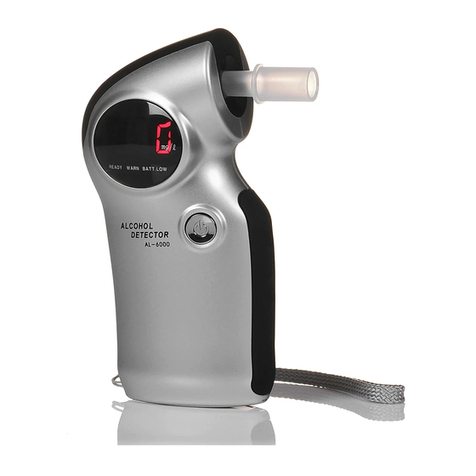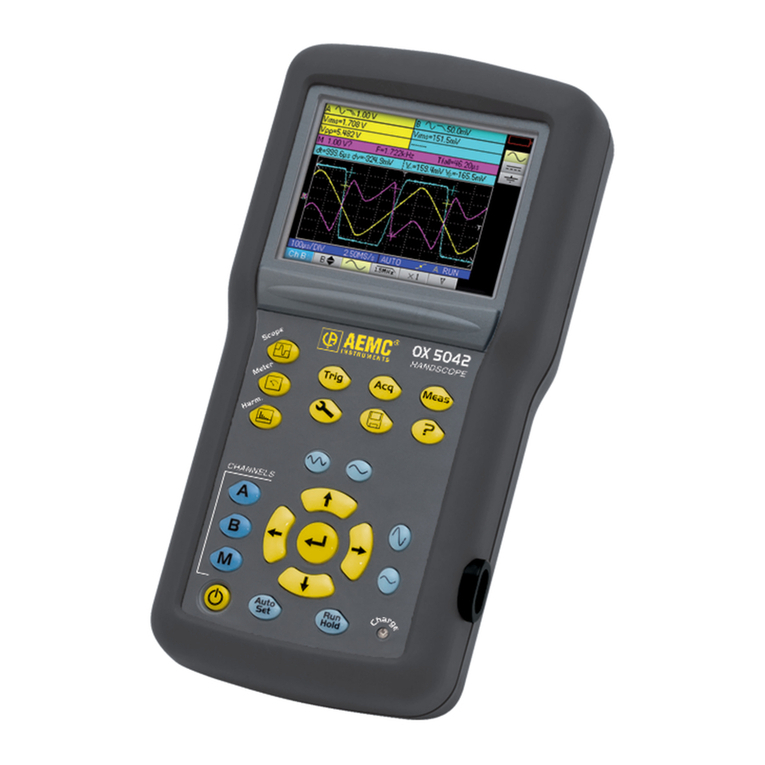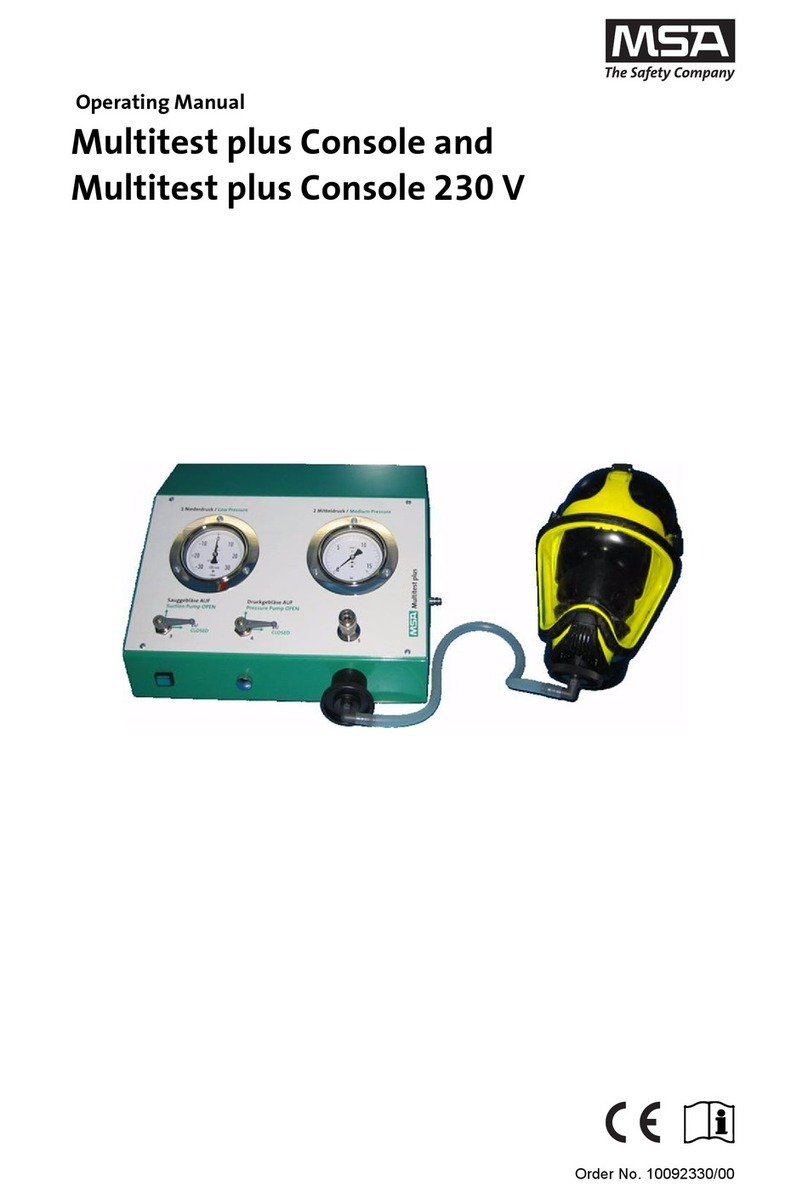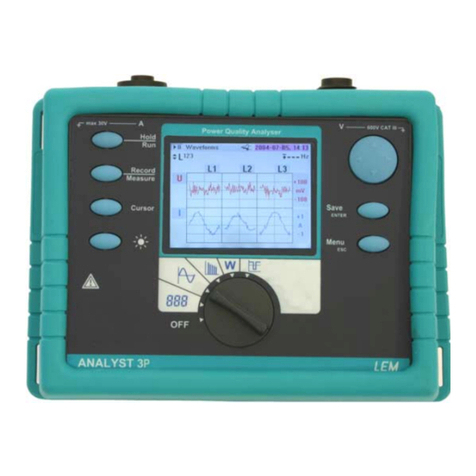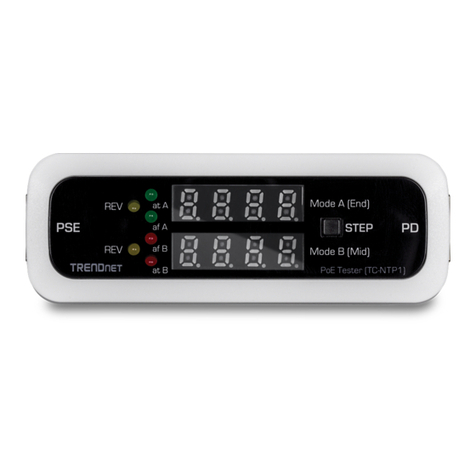Frye FONIX 6500 Reference guide

6500 Quick Reference Cards
Target 2cc SSPL 90 ................................................................................ 2
Target 2CC FOG........................................................................................ 2
Quik-Probe (Automatic) Insertion Gain (IG)Test ....................................... 3
Quik-Probe (Automatic) SPL Target Test ................................................... 3
AGC/Adaptive AGC ANSI S3.22-1987 Test ............................................... 4
Linear ANSI S3.22–1987 Test.................................................................... 4
Multi-Curve—Pure Tone............................................................................. 5
Multi-Curve—Composite............................................................................ 5
IECTest...................................................................................................... 6
Linear ANSI S3.22-1996Test..................................................................... 7
AGC/Adaptive AGC ANSI S3.22-1996 Test ............................................... 7
Telewand—ANSI ’96 Telecoil ..................................................................... 8
ANSI S3.22-1996 Specifications and Tolerances....................................... 9
ANSI S3.22–1987
Measurements, Specifications and Tolerances ................................. 10
ANSI S3.42–1992
Testing Hearing Aids with a Broad-Band Noise Signal....................... 11
Digital Speech in Noise—Sound Chamber .............................................. 12
Digital Speech in Noise—Probe............................................................... 12

6500–1
FONIX®6500TARGET 2CC F.O.G.
NOTE: Use the remote module for these procedures.
GENERAL PROCEDURE — using all AVERAGE EAR data:
a. In probe menu, highlight CREATE TARGET and select 2CC FOG.
b. Press [START], then enter audiogram.
c. Press [SWEEP/START] to select an insertion-gain formula.
d. Press [START/STOP] to continue
e. Set menu, if necessary (AVERAGE UNAIDED and AIDED).
f. Modify target curve, if desired.
g. Print; exit. (Result gets stored in REF 8).
CUSTOMizing for the UNAIDED EAR resonance:
a. Measure real-ear unaided response (REUR).
b. Do general procedure, but set UNAIDED EAR to CUSTOM in
menu.
CUSTOMizing for the AIDED EAR (RECD) impedance:
a. Measure 2cc-coupler response of insert earphone or BTE aid.
b. Copy 2cc-coupler response to REF 6.
c. Measure aided response (REAR) of same earphone or aid.
d. Do general procedure, but set AIDED EAR-2cc to CUSTOM in
menu.
CUSTOMizing for both UNAIDED EAR and AIDED EAR
(RECD) values:
a. Measure 2cc-coupler response of insert earphone or BTE aid.
b. Copy 2cc-coupler response to REF 6.
c. Measure unaided response (REUR).
d. Measure aided response (REAR) of earphone or aid.
e. Do general procedure, but set both UNAIDED and AIDED EAR-
2cc to CUSTOM in menu.
6500–1
FONIX 6500-CXTARGET 2CC SSPL 90
NOTE: Use the remote module for this procedure.
1. In the probe menu highlight CREATE TARGET
and select 2cc SSPL90. Press [START/STOP]
2. Use [∧ ∨, < >] buttons to enter comfort/
discomfort levels in dB HL.
3. (Optional) Press [MENU] to change the set-
tings.
4. Press [PRINT] to print.
5. Press [START/STOP] to exit.
Result is stored in REF 7 of Multi-Curve.

FONIX 6500-CX QUIK-PROBE
(Automatic) INSERTION GAIN (IG)TEST
6500–2
1. Enter probe menu by pressing [PROBE] (or [START/STOP] on
remote) and then pressing [MENU].
NOTE: From here on use only the remote module to enter
and test.
2. Use [∧ ∨] buttons to highlight MODE. Select COMP/AUTO
3. Use [∧ ∨, < >] buttons to highlight CREATE TARGET and select
INS. GAIN. Then press [START/STOP].
4. Use [∧ ∨, < >] buttons to enter HTL audiogram info.
5. If desired, press [MENU] to change settings.
6. Press [START/STOP] to continue.
7. Mark probe tube (5mm / 1/4")
8. Place wedge ear hook on subject.
9. Place Ref. Mic on Velcro platform above ear, and probe tube in ear.
10. Position subject 12" from speaker at 45 degree angle.
11. Press [LEVEL].
12. Press [START/STOP] to run Unaided (REUR).
13. Hold probe tube in place, put hearing aid in ear, set to user gain
level.
14. Press [START/STOP] to run Aided (REAR).
15. Insertion Gain (REIR) & Target appear on upper graph.
16. Press [PRINT] to print.
6500–2
FONIX 6500-CX QUIK-PROBE
(Automatic) SPLTARGETTEST
1. Enter probe menu by pressing [PROBE] or [START/STOP] on
remote) and then pressing [MENU].
NOTE: From here on use only the remote module to enter
and test.
2. Use [∧ ∨, < >] buttons to highlight CREATE TARGET and
select SPL TARGET. Then press [START/STOP].
3. Press [MENU] to select and change settings.
4. Use [∧ ∨, < >] buttons to enter HTL audiogram info.
5. If desired, press [SWEEP START] to enter UCL levels.
6. Press [START/STOP] to continue.
7. Mark probe tube (5mm / 1/4")
8. Place wedge ear hook on subject.
9. Place Ref. Mic on Velcro platform above ear, and probe tube in ear.
10. Position subject 12" from speaker at 45 degree angle.
11. Press [LEVEL].
12. Hold probe tube in place, put hearing aid in ear, set to user
gain + output levels.
13. Press [UNAIDED] until AUTO appears at the bottom of the
screen.
14. Press [START/STOP] to run CRV 1 (50 dB COMP), then CRV 2
(65 dB COMP) and finally CRV 3 (90 dB BURST)
15. The graph will display T (threshold), U (UCL), MCL Target
(thick line ), and CRV 1, 2, and 3.
16. Press [PRINT] to print.
TEST COMPLETE
TEST COMPLETE

FONIX 6500-CX LINEAR
ANSI S3.22–1987TEST
1. LEVEL (only if UNLEVELED)
2. Attach hearing aid & coupler to microphone, set full on
gain, place in test box.
3. Press [MENU], then [ANSI]. Select ANSI S3.22-1987
4. Press [MENU]. Use [∧ ∨, < >] buttons to select:
AID TYPE: LINEAR
FULL ON GAIN: 60 dB (or 50 dB for high gain aids).
TELECOIL: DISABLED or ENABLED
AVERAGE FREQUENCIES: HFA 1000, 1600, 2500 or
SPA (specified by manufacturer).
SWEEP DELAY: 50 mS (default)
5. Press [START] to run test.
6. The test may stop to turn down VC for Reference Test
Gain. Follow instructions on screen.
7. Press [CRT] to print.
8. Press [CONTINUE] to return to ANSI Test Menu choice
and [CONTINUE] again to exit.
Press [START] to run another test
6500–36500–3
6500-CX AGC/ADAPTIVE AGC
ANSI S3.22-1987 TEST
1. LEVEL (only if UNLEVELED).
2. Attach hearing aid & coupler to microphone, set full on
gain, place in test box.
3. Press [MENU], then [ANSI]. Select ANSI S3.22-1987
4. Press [MENU]. Use [∧ ∨, < >] buttons to select:
AID TYPE: AGC with EIN
AGC without EIN
ADAPTIVE AGC with EIN
ADAPTIVE AGC without EIN
FULL ON GAIN: 50 dB will be selected automatically
TELECOIL: DISABLED or ENABLED
AVERAGE FREQUENCIES: HFA 1000, 1600, 2500 or
SPA (specified by manufacturer).
SWEEP DELAY: 50 mS (default)
5. Press [START] to run test.
6. Press [CRT] to print.
Press [START] to run another test
TEST COMPLETE TEST COMPLETE

FONIX 6500-CX
Multi-Curve—Composite
(Software Version 2.50 and up)
Procedure: Using Multi-Curve to test four different hearing aids.
The key to understanding COMPOSITE MULTI-CURVE is that the first test
stored always goes into CURVE 2, and CURVE 1 is always in Real-Time.
1. Place hearing aid "A" in the test box at full-on gain, set 6500 Amplitude
[∧ ∨] at 60 dB RMS, when the real time curve is stable, press [FREEZE]
and then the [START] button to store this test into the Multi-Curve Stack.
2. To test hearing aids "B" and "C", repeat Step 1.
3. To test hearing aid "D", DO NOT PRESS [FREEZE] and [START]
buttons; just place the coupled aid in the test box.
4. Press [MULTI] button.
5. Use arrow buttons [∧ ∨] to select (highlight) "Multiple Curves."
6. Press [START] to display Curves 1, 2, 3, and 4.
Note: Curve 1 will be in Real-Time on the display —this is the test currently
being run in the test box. When you press [CRT] to print it will freeze and
print out.
IMPORTANT: Because curves are STACKED one on top of the other in
Multi-Curve, they are now in reverse order of how you tested them. Example:
STACK
4th TEST Hearing Aid "D" = CURVE 1
3rd TEST Hearing Aid "C" = CURVE 2
2nd TEST Hearing Aid "B" = CURVE 3
1st TEST Hearing Aid "A" = CURVE 4
CLEARING OLD CURVES; 1) Re-test over the old curves; 2) Enter Multi-
Curve Menu and select "Clear Curves"; 3) Use [FREEZE] to "Deselect a curve.
VARIATIONS:
1. Use one hearing aid and test at four (4) different volume control settings.
2. Use one hearing aid and test at four (4) different amplitude levels, i.e.
50dB, 60dB, 70dB and 80dB.
6500–4
6500–4
Procedure: Using Multi-Curve to test four different hearing aids. All
these test examples can be run as either SPL or Gain.
1. Press [SINE/COMPOSITE] to enter SINE/Pure Tone mode.
2. Select SPL or Gain, then select source input level.
3. Test hearing aid "A" in the test box.
4. Test hearing aid "B" in the test box.
5. Test hearing aid "C" in the test box.
6. Test hearing aid "D" in the test box.
7. Press [MULTI] button to enter the option.
8. Use arrow buttons [∧ ∨]to select (highlight) "Multiple Curves."
9. Press the [START] button to display CURVES 1, 2, 3 and 4.
IMPORTANT: Because the curves are STACKED one on top of another
in Multi-Curve, they are now in reverse order of how you tested them.
Example: STACK
4th TEST Hearing Aid "D" = CURVE 1
3rd TEST Hearing Aid "C" = CURVE 2
2nd TEST Hearing Aid "B" = CURVE 3
1st TEST Hearing Aid "A" = CURVE 4
CLEARING OLD TEST CURVES: Re-test directly over old curves, or
enter Multi-Curve Menu and select "Clear Curve" menu choice, or use
[FREEZE] to "Deselect" a curve.
VARIATIONS:
1. Use one hearing aid at four (4) different volume control settings, i.e.
1/3, 1/2, 2/3, etc.
2. Use one hearing aid at four (4) different signal amplitudes, i.e. 50dB,
60dB, 70dB and 80dB.
FONIX 6500-CX
Multi-Curve—PureTone
(Software Version 2.50 and up)

FONIX 6500-CX
IECTEST
1. LEVEL (only if UNLEVELED)
2. Attach the hearing aid and appropriate coupler to
microphone.
3. Linear aids—set to full-on gain
Compression aids—set to maximum output (usually
minimum compression).
4. Place in test box.
5. Press [MENU], then [IEC].
Use the [< >, ∧ ∨] buttons to select parameters:
AID TYPE: LINEAR, AGC, or ADAPTIVE AGC
FULL ON GAIN: 50 dB or 60 dB
REFERENCE TEST FREQUENCY: 2500 Hz or 1600 Hz
HARMONIC DISTORTION FREQUENCY: 400 Hz–
1600 Hz (200-Hz increments)
SWEEP DELAY: .02–1.0 seconds
6. Press [START] to run the test.
7. When the test stops, turn down aid to match Reference
Test Gain. Follow instructions on screen.
8. Press [CRT] to print.
9. Press [START] run another test, or press [CONTINUE]
or [IEC] to exit.
TEST COMPLETE
6500–5

1. LEVEL (only if UNLEVELED).
2. Attach hearing aid and coupler to microphone, set full on gain,
place in sound chamber.
3. Press [MENU] then [ANSI]. SelectANSI 3.22-1996.
4. Press [MENU]. Select:
• AID TYPE: LINEAR
• TELECOIL: ON or OFF
• AVG FREQUENCIES: 1000, 1600, 2500, or SPA closest to
manufacturer’s specifications.
• HDIST 12DB: ON or OFF
• EAR: RIGHT, LEFT, or NONE to be designated on SPLITS curve.
The next three selections are sub-menus. Press [START] to
enter submenu and [CONTINUE] to exit sub-menu.
• FOG MENU: 60db (50dB for high gain aids; print CURRENT
screen, orALL the screens.
• AGC MENU: Not applicable for linear aid test.
• DELAY MENU: default settings will work for most aids. See
manual for details.
5. Press [START] to run test.
6. The test may stop for you to turn down volume on aid to match
reference test gain. Press [CONTINUE] when completed.
7. After the test is completed, press ∧and ∨ to view different screens
for test. [CRT] prints screen.
8. Press [CONTINUE] to return to ANSI test menu choice and
[CONTINUE] again to exit.
TEST COMPLETE
FONIX 6500-CX LINEAR ANSI S3.22-1996 TEST
2/11/00 6500–6
1. LEVEL (only if UNLEVELED)
2. Attach hearing aid and coupler to microphone, set full on gain, place in
sound chamber.
3. Press [MENU] then [ANSI]. Select ANSI 3.22-1996.
4. Press [MENU]. Select:
• AID TYPE:AGC WITH EIN or ADAPTIVE AGC
• TELECOIL: ON or OFF
• AVG FREQUENCIES: 1000, 1600, 2500, or SPA closest to
manufacturer’s specifications.
• HDIST 12DB: ON on OFF
• EAR: RIGHT, LEFT, or NONE to be designated on SPLITS curve.
The next three selections are sub-menus. Press [START] to enter
submenu and [CONTINUE] to exit sub-menu.
• FOG MENU: 50 dB only option for AGC aids; print CURRENT
screen, or ALLthe screens.
• AGC MENU:Attack and release times will be measured for frequencies
turned on. Choose appropriate ATTACK WINDOW and
RELEASE WINDOW.
• DELAY MENU: default settings will work for most aids. See manual
for details.
5. Press [START] to run test.
6. The test may stop for you to turn down volume on aid to match
reference test gain. Press [CONTINUE] when completed.
7. After the test is completed, press ∧and ∨ to view different screens for
test. [CRT] prints screen.
8. Press [CONTINUE] to return to ANSI test menu choice and [CON-
TINUE] again to exit.
TEST COMPLETE
FONIX 6500-CX AGC/ADAPTIVE AGC
ANSI S3.22-1996 TEST
2/11/00 6500–6

Determining a proper position, one with little
magnetic noise, is vital to effective telecoil testing.
Test the area where the telecoil measurement is to be made for
magnetic fields before beginning the ANSI ’96 test sequence.
a. Connect the hearing aid to a 2 cc coupler and set the aid for
“T”with the gain full on. Do not place the measurement
microphone into the coupler. Rather, use the coupler as a
megaphone so that you can hear its output.
b. Place the aid in the physical location where the test is to
occur.
c. Listen to the output from the aid. Do you hear a buzz,
indicating that the area has magnetic noise? Does the
analyzer’s CRT monitor cause the noise? This can be deter-
mined by shutting the monitor off for a brief period of time.
d. When the area has been tested and found to be free of
undesirable levels of unwanted magnetic fields, then the aid
can be tested for magnetic pickup sensitivity using the ANSI
’96 sequence. If monitor noise is found to be unacceptable,
then it may be necessary switch off the monitor during the
telephone coil test.
7/99 6500-7
FONIX 6500-CX
Telewand—ANSI ’96Telecoil
Important Note: Please read
the instructions on the back of
this card before proceeding.
If you have selected “TELECOIL:
ON,”do the following when the
ANSI ’96 sequence stops for the
telecoil measurement.
1. Open the lid of the sound chamber.
2. Switch the aid to telecoil mode. Do not alter the gain control.
3. Position the aid where there is the least magnetic noise*. To
guide you, a continuous reading of the output is on the screen.
4. Once you have determined the best position, plug the telewand
into the side of the sound chamber, just below where the sound
chamber connects to the Frye box.
5. Now relative to the aid, bring the telewand into position as if it
were the earpiece on a phone. Keeping the telewand as parallel
as possible to the faceplate of an ITE aid or as flat as possible
against the body of a BTE aid, move it around until you find the
position that returns the most gain. Again, use the continuous
reading on the screen to guide you.
6. If it is necessary, turn the monitor off to reduce the magnetic
noise.
7. Press [CONTINUE] to measure the SPLITS curve and STS. Turn
the monitor back on when the signal stops.
8. Return the aid to the normal mode, and press [CONTINUE].
*See other side of this card 6500–7

ANSI S3.22-1996 Specifications andTolerances
OSPL90 Curve: Max SPL shall not exceed the mfgr. spec. by +3 dB
HFA-OSPL90 or SPA-OSPL90: Shall be within ±4 dB of mfgr. spec.
Full-on Gain (FOG): 50 or 60 dB inputs
HFA-FOG or SPA-FOG: within ±5 dB of mfgr. spec.
Reference Test Gain: information only
Freq. Response Curve: 50 dB input AGC, 60 dB input all others
Freq. Range: low band ±4 dB, high band ±6 dB
Harmonic Ditortion: Shall not exceed mfgr. specified percentage by +3%
Equivalent Input Noise: Shall not exceed mfgr. spec. by + 3 dB.
Battery Current: Shall not exceed mfgr. spec + 20%
HFA-SPLITS: within ±6 dB of mfgr. spec.
AGC Aids:
I/O—within ±5 dB; Attack and Release—within ±5 ms or ±50 % whichever is larger
2/11/00 6500-8

ANSI S3.22–1987
Recommended Measurements,Specifications and Tolerances
SSPL9O CURVE: Max. shall not exceed that spec. mfgr + 3dB
HFA-SSPL9O or SPA-SSPL9O: Shall be within ±4 dB of mfgr. spec.
FULL-ON GAIN: 50 or 60 dB inputs
HFA/FOG or SPA/FOG: Within ±5 dB of mfgr. spec.
REFERENCE TEST GAIN: Shall be stated for info only
FREQUENCY RESPONSE CURVE: 60 db input
FREQUENCY RANGE: (f1 - f2): f1 ±4 dB, f2 ±6 dB
HARMONIC DISTORTION: (Total Harmonic Distortion), gain in ref. test postion, 70 dB at 500, 800, and 65dB at 1600 Hz
or frequencies corresponding to 1/2 the freq. of each SPA frequency. Shall not exceed specs
plus 3%.
Note: If a rise of 12 dB or more occurs between the test freq. and its second harmonic, the test
at that freq. may be omitted.
EQUIVALENT INPUT NOISE LEVEL:1000, 1600, and 2500 Hz or the 3 SPA freq., shall not exceed spec plus 3%
BATTERY CURRENT: 1000 Hz, 65 dB, Ref Test Pos., shall not exceed spec plus 20%
(To calculate estimated battery life: Capacity Rating (MAH) = Hours)
Current drain (MA)
INDUCTION COIL (Telecoil): l0mA/m at 1000 Hz, full-on, within ±6 dB of spec
AGC HEARING AIDS: Input-Output Characteristics, not more than ±5 dB
Attack & Release Times, shall be within ±5 ms or 50%, whichever is larger
2/17/98 6500-9

ANSI S3.42–1992
Testing Hearing Aids with a Broad-Band Noise Signal
Definitions (Tolerances are unavailable)
NSPL90: Maximum RMS output sound pressure level (SPL) produced with a 90dB RMS speech-weighted noise input SPL signal.
Full-On Noise Gain: Maximum gain with a 60dB SPL noise input signal. (Note: This test may not elicit a true reading of maximum
gain for hearing aids with an onset of non-linear operation below 60dB.)
Actual Reference Gain: The measured amount of gain when the hearing aid is set to full on or the gain after the volume control
has been adjusted to ±1 dB of the Target Reference Gain.
Target Reference Gain: This information is only displayed when the measured gain is greater than the calculated Actual Reference
Gain. This target is used to adjust the hearing aid's actual gain to a level of ±1 dB of the target. The figure is calculated by adding
the 60dB SPL input + 17dB and subtracting it from the NSPL90 RMS output. (NSPL90 – 77 = Target Reference Gain)
Family of Frequency Response Curves: These curves are developed by adjusting the noise input level in 10-dB steps over a
selected range. The preferred levels are 50, 60, 70, 80, and 90dB SPL. Frye has added 40dB SPL to the preferred levels.
Noise I/O Curve: This demonstrates the compression or limiting of the non-linear circuit.
Test Specifications: Stated for information purposes only. Please refer to the operator's manual for a complete description of each
test specification.

2/11/00 6500-10
6500-CX Digital Speech in Noise—
Sound Chamber
1. Level (only if unleveled)
2. Set up the hearing aid and coupler with the
microphone. Place in the sound chamber.
3. Press [MENU] and then [*].
4. Select DIGITAL SPEECH IN NOISE. Press [START].
5. Press [MENU] to change the signal type (choices:
ICRA or ANSI) and to activate the bias tone.
6. Use the [< >] buttons to adjust the bias tone
frequency.
7. Press [START] to switch control of the [∧∨]
buttons from the source amplitude to the bias
tone amplitude.
8. Use the [∧∨] buttons to set the amplitude.
2/11/00 6500-10
6500-CX Digital Speech in Noise—
Probe
1. Follow the instructions to do SPL testing.
2. Once in the main SPL testing screen press menu
3. Select DIGSP ICRA or ANSI as the test signal for
AIDED CURVES 1 and 2. Leave AIDED CURVE 3 as
PT BURST
4. Select DIG SP MENU. Press [START/STOP].
5. Activate the bias tone and set its frequency and
amplitude. It will be presented whenever a digital
signal is used. You must turn the bias signal off in
this menu.
6. Press [MENU] twice to return to the main test
screen.
7. Continue to follow the SPL testing instructions.
This manual suits for next models
1
Table of contents
Other Frye Test Equipment manuals
Popular Test Equipment manuals by other brands
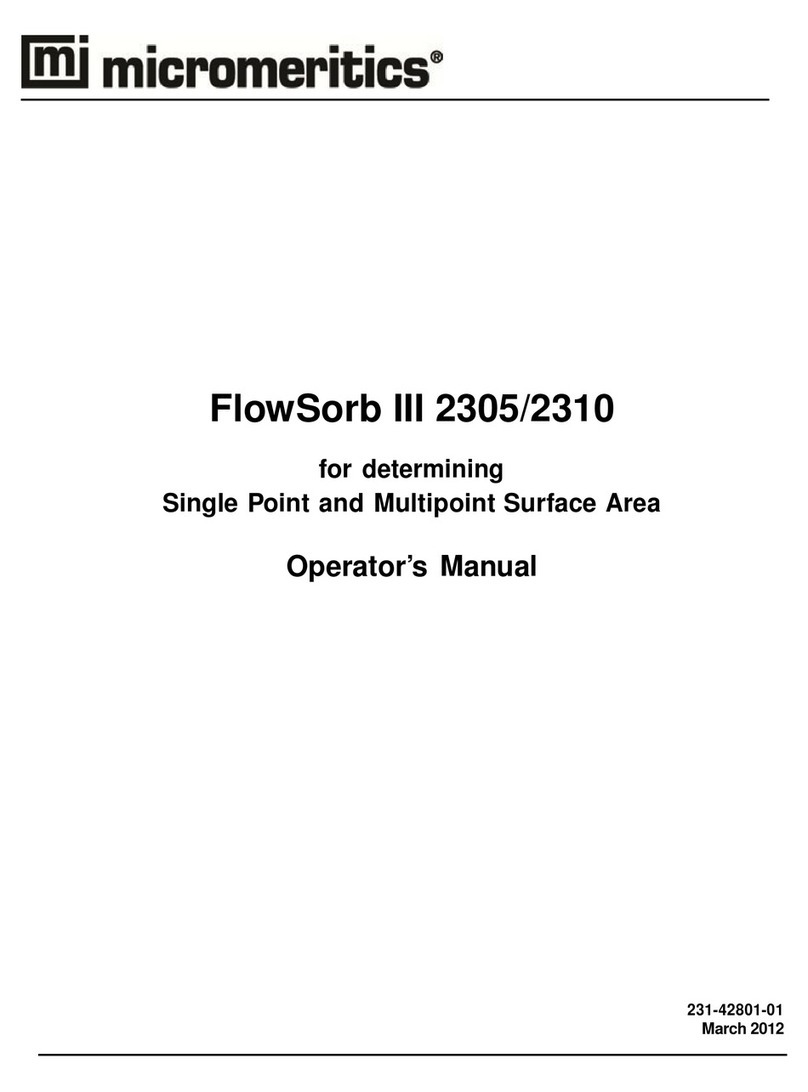
Micromeritics
Micromeritics FlowSorb III 2305 Operator's manual
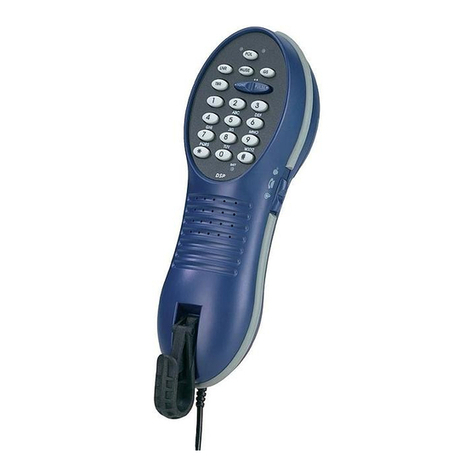
Textron
Textron Tempo Compact DSP user guide

Cole Parmer
Cole Parmer 90225-00 operating instructions

EXTOL Craft
EXTOL Craft 422800 Translation of the original user manual
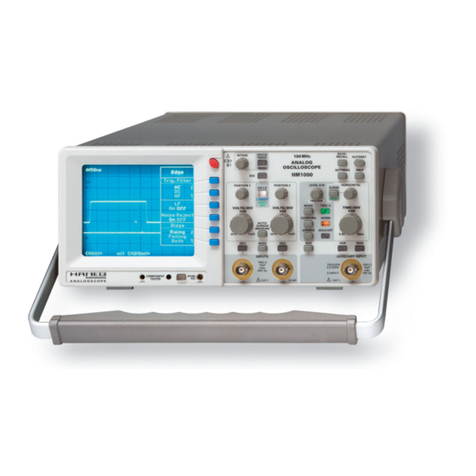
Hameg
Hameg HM1000 manual

Steinberg Systems
Steinberg Systems SBS-SMD-2999 user manual
